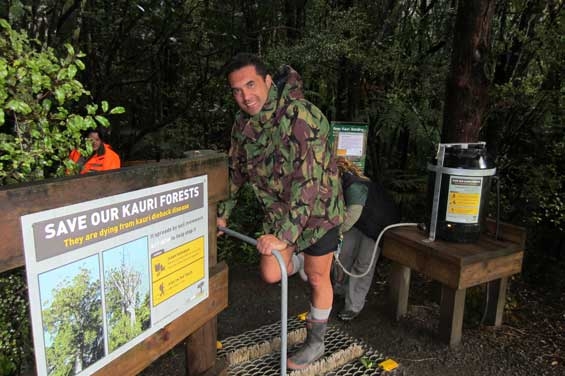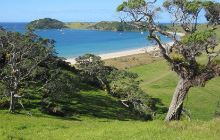Support from forest users and visitors is vital to the survival of kauri
Archived content: This media release was accurate on the date of publication.
Introduction
The second national Kauri Dieback Symposium held on 14 and 15 February 2015 in Hokianga highlighted that containment of the disease is currently our best weapon.Date: 09 February 2015
The second national Kauri Dieback Symposium held on 14 and 15 February 2015 in Hokianga aimed at creating a strategy and initiating practices to find a cure for PTA (Phytophthora taxon Agathis) - the disease that is killing our kauri trees.
Mita Harris, Northland Conservation Board chair and Master of Ceremonies at the symposium says, "What stood out for me from the symposium was that containment of the disease is currently our best weapon."

Northland Conservation Board Chair Mita Harris getting his boots cleaned at a cleaning station in Waipoua Forest to prevent the spread of kauri dieback (PTA)
"The Kauri Dieback Management Programme is focusing on implementing research findings and scoping longer-term research as well as management of areas with kauri present. This includes upgrading high use forest tracks to reduce risk. But until we can find a cure, everyone visiting or working in our forests – from forestry workers, trappers, and pig hunters to recreational users such as trampers or mountain bikers, must take responsibility to help stop the spread of the disease" says Mita Harris.
Mita Harris says, "PTA is a fungus-like disease. The spores live in soil and are spread with soil movement. Dirty footwear, animals, equipment, and vehicles can spread PTA from infected areas to healthy areas of kauri."
"Kauri forests are critically important to all New Zealanders and kauri play a vital role in our culture, history, landscapes, ecosystems, and economic growth. We need to raise awareness that kauri dieback is a serious biosecurity risk or we could lose kauri completely within 50-100 years."
"If you are visiting or working in kauri forests, the Northland Conservation Board is appealing to you to make sure your shoes, tyres, and equipment are cleaned to remove all visible soil and plant material before and after visiting. Please use the cleaning stations installed on major tracks, and stay on the track and off kauri roots."
"The Northland Conservation Board will continue to support the efforts of the Kauri Dieback Management Programme and any community and iwi/hapu initiatives as much as we can," says Mita Harris.
Contact
Mita Harris
Northland Conservation Board Chair
Phone: +64 27 584 4332


